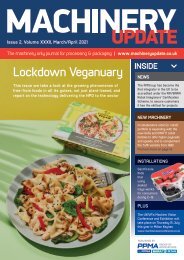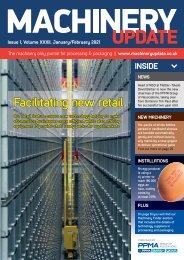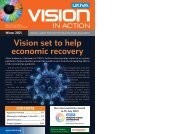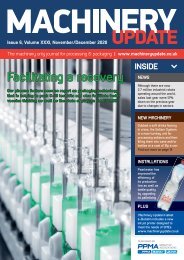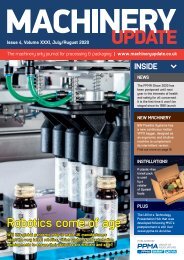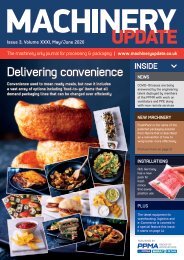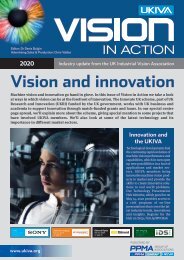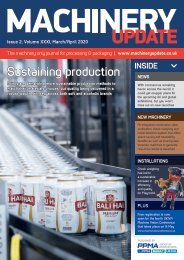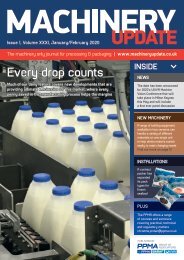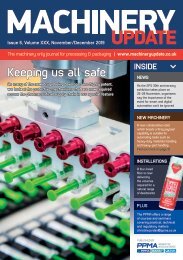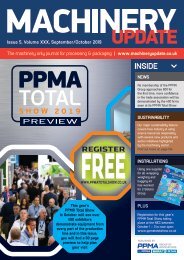Vision in Action Autumn 2019
You also want an ePaper? Increase the reach of your titles
YUMPU automatically turns print PDFs into web optimized ePapers that Google loves.
18<br />
3D MARKET SECTORS (2)<br />
Transport & <strong>in</strong>frastructure<br />
Autonomous driv<strong>in</strong>g; road roughness and rutt<strong>in</strong>g; pavement edge<br />
condition; tyre-to-pavement contact area; sag and hump <strong>in</strong>spection;<br />
preventative ma<strong>in</strong>tenance for rail tracks.<br />
Rubber & tyre<br />
Rubber extrusion profil<strong>in</strong>g; strip guidance; splice control; layer control;<br />
bulge and dent; radial and lateral runout; tyre mark<strong>in</strong>gs; DOT-Code<br />
identification.<br />
General manufactur<strong>in</strong>g<br />
Pick and place; robot assembly; size; shape; volume; surface f<strong>in</strong>ish<br />
measurements for quality control; part to part comparison; part to CAD<br />
comparison.<br />
Wood<br />
Log optimisation <strong>in</strong> the sawmill; headrig applications; end-dogg<strong>in</strong>g<br />
applications;<br />
cant edger and gang saw optimisation; transverse board edg<strong>in</strong>g and<br />
trimm<strong>in</strong>g; f<strong>in</strong>ished lumbar grad<strong>in</strong>g; tracheid detection; quality control of<br />
gang lumber size mach<strong>in</strong>ery.<br />
Logistics<br />
Pallet management; collision avoidance; optimis<strong>in</strong>g space usage <strong>in</strong><br />
freight transport and warehous<strong>in</strong>g; real time track<strong>in</strong>g of resources and<br />
assets on the factory floor; shipp<strong>in</strong>g strategies; carton/object<br />
dimension<strong>in</strong>g and profil<strong>in</strong>g.<br />
Tyre DOT Code read<strong>in</strong>g (Courtesy Stemmer Imag<strong>in</strong>g)<br />
CHOOSING A 3D SYSTEM<br />
Each of the four ma<strong>in</strong> 3D imag<strong>in</strong>g techniques has performance characteristics that should be considered when evaluat<strong>in</strong>g<br />
a system for a particular application. All of these techniques have been used <strong>in</strong> robot vision applications.<br />
Stereo vision<br />
Stereo vision mimics human depth perception. Passive stereo vision<br />
requires well-textured surfaces with good light<strong>in</strong>g, but textureless<br />
surfaces and poor light<strong>in</strong>g conditions require active stereo vision us<strong>in</strong>g<br />
a random pattern light projector. With depth resolution to the millimetre<br />
level, the technique is good for co-ord<strong>in</strong>ate measurement and the 3D<br />
measurement of workspaces. It offers high accuracy <strong>in</strong> measur<strong>in</strong>g<br />
objects with a small work<strong>in</strong>g range. It benefits from hardware<br />
acceleration <strong>in</strong> production l<strong>in</strong>e applications.<br />
Laser Triangulation<br />
The laser triangulation method creates 3D shape profiles from laser l<strong>in</strong>e<br />
displacement. It requires the object to be mov<strong>in</strong>g <strong>in</strong> order to build up the<br />
3D model, but delivers very precise detail on even on surfaces with low<br />
contrast. Reflect<strong>in</strong>g or absorb<strong>in</strong>g surfaces can be more difficult. It works<br />
well at short distances and provides depth resolution at the µm level.<br />
Hardware acceleration is needed for high speed <strong>in</strong>l<strong>in</strong>e <strong>in</strong>spections.<br />
Structured Light<br />
Depth data is calculated from the displacement of light patterns by the<br />
object. With micron level depth resolution, the technique works<br />
<strong>in</strong>dependently of the object’s texture and results <strong>in</strong> high 3D<br />
reconstruction quality. It works well even with sh<strong>in</strong>y metallic, dark,<br />
absorb<strong>in</strong>g, or partly translucent objects and also offers good acquisition<br />
speeds.<br />
Time of Flight<br />
Depth measurements are made by measur<strong>in</strong>g the time it takes for<br />
emitted light to be reflected. It is very effective for generat<strong>in</strong>g depth data<br />
and for measur<strong>in</strong>g distances. With a millimetre depth resolution, it is<br />
good for volume measurements, pallet<strong>in</strong>g tasks and collision avoidance<br />
<strong>in</strong> logistics and warehouse applications. It operates at high speed and<br />
works well with medium distances, but may be affected by bright<br />
ambient light and reflective or absorb<strong>in</strong>g surfaces.<br />
Stereo <strong>Vision</strong> Time of Flight Laser Triangulation Structured Light<br />
Active/Passive Passive (active us<strong>in</strong>g pattern projector) Active Active Active<br />
Depth resolution mm mm µm µm<br />
Depth accuracy Medium Medium Very high Very high <strong>in</strong> short range<br />
Distance and range 2m - 5m (depend<strong>in</strong>g on basel<strong>in</strong>e) Scalable 30 - 50cm to 20 - 50m cms Scalable cm to 2m<br />
Low light behaviour Poor Good Good Good<br />
Outdoor light Good Variable Poor Poor<br />
Speed 100 Hz 60 Hz Tens of Hz Tens of Hz<br />
Mov<strong>in</strong>g Object Mov<strong>in</strong>g or stationary Mov<strong>in</strong>g or stationary Mov<strong>in</strong>g Mov<strong>in</strong>g or stationary<br />
Cost Medium Low Medium High<br />
Thanks to UKIVA members ClearView Imag<strong>in</strong>g, IDS Imag<strong>in</strong>g Development Systems, Multipix Imag<strong>in</strong>g, Scorpion <strong>Vision</strong>, Sick (UK),<br />
Sony Image Sens<strong>in</strong>g Solutions and Stemmer Imag<strong>in</strong>g for their <strong>in</strong>put to this feature.<br />
www.ukiva.org




